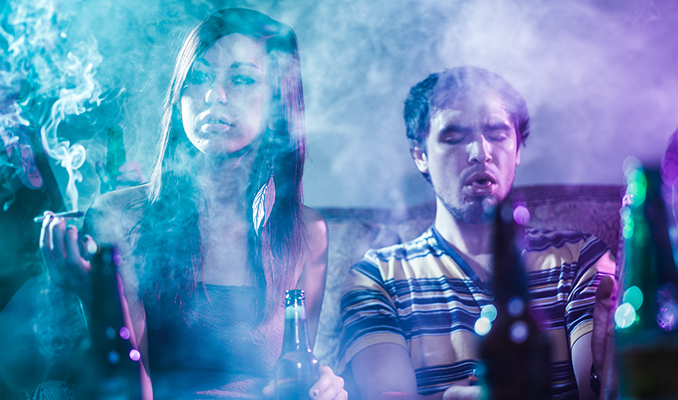Can Weed Smoke Give You A Contact High?
Published :
Jun 16, 2018
Categories :
Medical cannabis

We all know the health risks associated with passive smoking when it comes to tobacco. But how secondhand cannabis smoke affects non-smokers is still something of a mystery. In this blog, we investigate the contact high and scrutinise the scientific research for an answer.
IS A CONTACT HIGH FROM WEED SMOKE A REAL POSSIBILITY?
Nope. In the real world, there is no such thing as a contact high. At least not from secondhand cannabis smoke. There is still great debate about this because the term is frequently confused with the placebo effect, and fanciful stoner lore suggests otherwise. To be clear, a “contact high” is supposed to be the high a non-smoker experiences in close proximity to cannabis smokers.
However, when you smoke weed, the THC is absorbed in the lungs. Hotbox a room into a haze cloud and the non-smokers still won’t get high. The exhaled smoke is very low in cannabinoids as the primary user has already inhaled all the fun stuff. Moreover, the prospect of a person feeling a contact high outdoors at a festival or a concert, for example, is completely laughable.
Sure, a non-smoker might come down with a case of red-eye from being in a smoky atmosphere, and they will certainly carry a musk of marijuana around with them from the session. But they will not be under the influence of cannabis. Never judge a book by its cover, and be reasonable about what you expect from your reefer.
Think about it logically; tourists would be dropping and flopping to the floor three steps past the front door of an Amsterdam coffeeshop if the contact high was a real-world happening. Customers would be completely stoned before they could even place an order with the budtender in a busy club. It just doesn’t work that way. Although it might sound hilarious, it would make weed too effective. And it would definitely be bad for coffeeshop business.
WHAT ARE THE EFFECTS OF PASSIVE CANNABIS SMOKING?
Some have rushed into reefer madness regarding the subject, mostly because of research by Professor Matthew Springer of the University of California, San Francisco. His rat study, published in prestigious Journal of the American Heart Research Association in 2016 reignited the fire in the belly of the cannabis prohibitionists.
They’ve been having a rough time as of late, so it’s no surprise they’ve had to form coalitions with other “anti” something organisations. “Marijuana secondhand smoke” is a term that links SHS or secondhand smoking with cannabis in a negative connotation. This is the cement that holds the coalition of prohibitionists and anti-secondhand-tobacco-smoke crowd together.
The aforementioned rat study is also the source of the recent sensational anti-cannabis soundbite. You may have heard “marijuana smoke is three times worse for you than tobacco”. That’s a falsehood masquerading as a fact based on questionable research. The truth is, we do not have the data based on human studies to make a definitive statement.

WILL SECONDHAND SINSEMILLA SMOKE MAKE ME FAIL A DRUG TEST?
Recent research suggests that yes, indeed you will test positive for cannabis metabolites if you’re locked in a hotbox full of smokers. A study published in 2014 online in the Journal of Analytical Toxicology is hard to quibble with. Don’t jump to conclusions and mistake this as reopening the door to the contact high theory. That myth is still busted.
It all depends on how low the cutoff point for the drug screening is. Essentially, exposure to secondhand marijuana smoke probably won’t cost you a government job in the US; at the federal workplace 50ng/ml cutoff point for urinalysis, you have a 99.6% chance of passing.
However, private companies may screen more rigorously. The same study concluded, “whereas initial tests with a 20ng/ml cutoff concentration produced multiple positive results”.
THE LAST WORD ON SECONDHAND CANNABIS SMOKE AND THE CONTACT HIGH
Cannabis for research purposes is supplied to US researchers by the National Institute on Drug Abuse. Unfortunately, it’s bunk bud that most ordinary decent stoners would avoid. For starters, it’s low-grade, containing 5–11% THC on average and derived from unknown strains. This makes as much sense as testing wine sommeliers with white spirits.
So long as cannabis research is restricted by its schedule 1 status, we are never going to get high-quality research data that holds true in the real world. There might be potential to create the conditions to get high from secondhand cannabis smoke in a laboratory, but until we start vacuum-sealing human test subjects into Perspex boxes filled with plumes of secondhand Kush fog, we’ll never be sure.






































